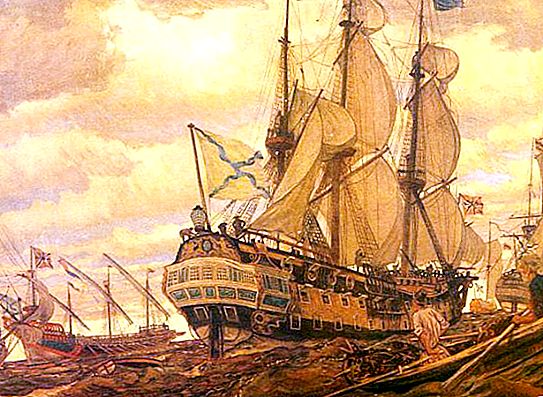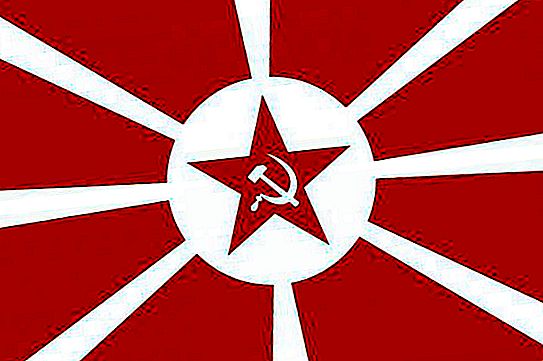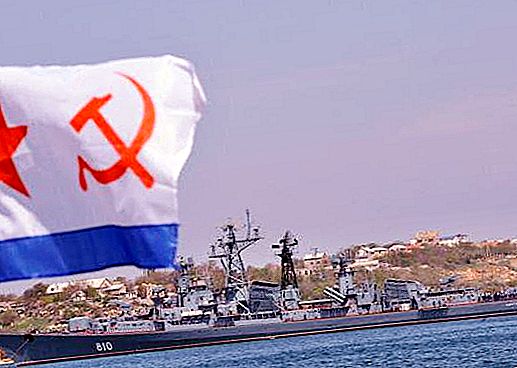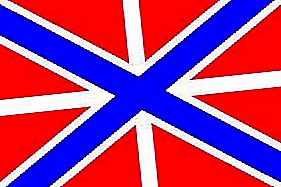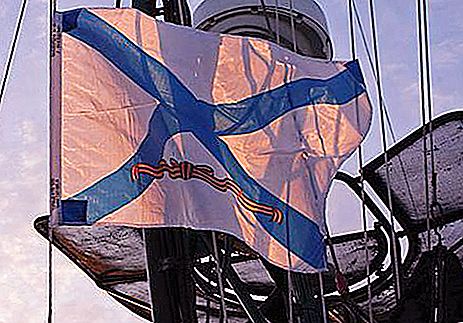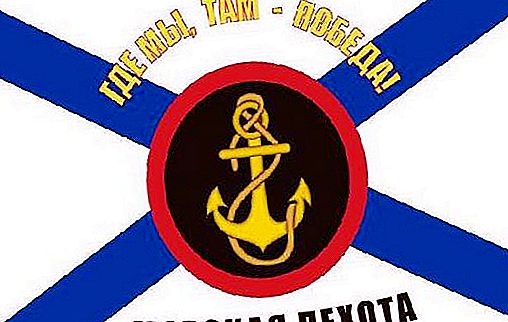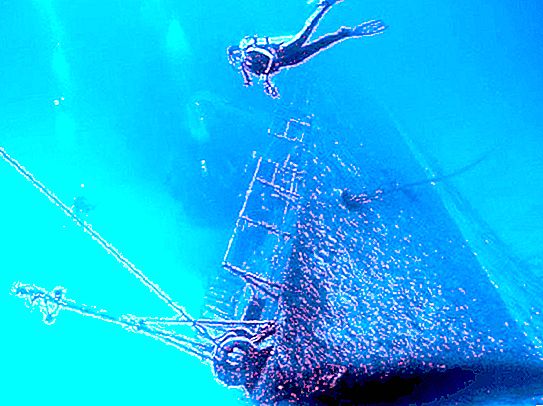Traditions are honored in the Navy, they observe old rituals and cherish symbols. Everyone knows that the main flag of the Russian Navy is the St. Andrew’s flag, proudly fluttering on the masts and main-posts of the first imperial sailing ships of the Peter's fleet. However, not everyone knows that already then there were other sea flags, which differed in function and informative orientation. This situation is valid today.
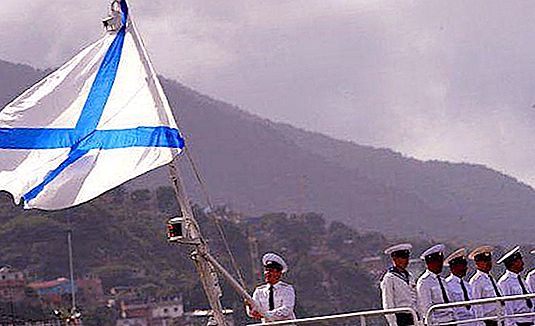
Birth of St. Andrew's flag
The Russian fleet was created by Peter the Great, he also took care of his symbols. He drew the first sea flags himself and went through several options. The chosen version was based on the “oblique” St. Andrew’s cross. It was this option, which became the eighth and last, that served until the October Revolution of 1917. Autumn cross st. St. Andrew the First-Called, Russian ships won many victories, and if they suffered defeats, the glory about the heroism of sailors survived generations and shines today.
St. Andrew the First-Called
The reason why this particular symbol was chosen has a deep meaning. The fact is that the first disciple of Christ Andrew the First-Called, the brother of the Apostle Peter, is considered both the patron saint of seafarers (he himself was a Galilean fisherman) and Holy Russia. In his wanderings, he visited, among many other cities, Kiev, and Novgorod the Great, and the Volkhov, preaching the Christian faith. The apostle Andrew received a martyrdom on the cross, while the executioners crucified him not on a straight, but on an oblique cross (the concept and name of this symbol arose).
The final naval flag of Russia in the final Petrovsky version looked like a white cloth crossed out with a blue cross. He is like that today.
Soviet period
In the first years after the revolution, the Bolsheviks did not attach great importance to naval power. During the Civil War, almost all fronts were land, and when the devastation came, there simply were no means to maintain sophisticated equipment. The few ships of the river and sea flotillas that remained at the disposal of the new government raised the red flag. The leadership of the workers 'and peasants' army and comrade L. D. Trotsky were contemptuous of maritime traditions, heraldry, symbols, history, and the like “dust of the old world”.
In 1923, the former officer of the tsarist fleet, Ordynsky, nevertheless convinced the Bolsheviks to accept a special flag for the ships, offering a rather strange version - an almost complete copy of the Japanese banner with the red army sign in the center. This flag of the navy of the RSFSR fluttered on yards and flagpoles until 1935, then it had to be abandoned. Imperial Japan became a likely adversary, and from afar the ships could be easily confused.
The decision on a new Red Navy pennant was made by the CEC and the Council of People's Commissars of the USSR. Even then, some continuity was observed, white and blue colors appeared on it, borrowed from the St. Andrew’s banner, but, of course, a new symbol of the Soviet Navy could not do without a star and a sickle with a hammer, and red ones.
In 1950, it was slightly changed, reducing the relative size of the star. The flag acquired a geometric balance; objectively, it has become more beautiful. In this form, he existed until the collapse of the USSR and another year, while there was a mess. In 1992, on all the ships of the Russian Navy, the new (or rather, the revived old) Andreevsky naval flags were hoisted. The hue of the color of the cross did not quite correspond to historical tradition, but in general it was almost the same as under Peter the Great. Everything is back to square one.
What flags are in the fleet
Flags on the fleet are different, and their purpose is different. In addition to the usual Andreev’s feed sterns, ships of the first and second ranks also have gyus, but only when they park at the pier. After entering the sea, the stern flag flies on the mast or rods (at the highest point). If the battle begins, the state flag is hoisted.
Colored flags
The charter also provides for pennants of naval commanders of various ranks. Naval flags indicating the presence of commanders on board are indicated by a red panel, a quarter of which is the blue St. Andrew’s Cross on a white background. On the color field are:
- one star (white) - if on board the commander of the connection ships;
- two stars (white) - if the flotilla or squadron commander is on board;
- three stars (white) - if the fleet commander is on board.
In addition, there are other colored flags with the image of the coat of arms of the Russian Federation on a red background crossed out by two crosses, Andreevsky and straight white or with two intersecting anchors on the same background. This means the presence on the ship of the Minister of Defense or the Chief of General Staff.
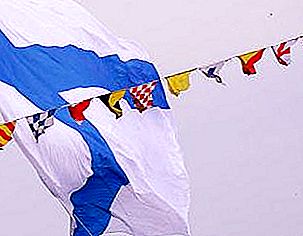
Signal flags
Information exchange, as in previous times, can be carried out through visual symbols, including marine signal flags. Of course, in the age of electronic means they are used extremely rarely and, rather, serve as a symbol of the inviolability of naval traditions, and on holidays, they adorn with their multicolor ball-gray uniformity of ship's camouflage, but if necessary, they can also fulfill their direct function. Sailors must be able to use them, and for this they need to study reference books, which contain all the flag signals. These volumes consist of sections that contain transcripts of geographical names, ship names, military ranks, and the like. Directories are two-flag and three-flag, with the help of many combinations you can quickly report the situation and transmit orders. Negotiations with foreign vessels are conducted through the International Code of Flag Signals.
In addition to pennants, meaning whole phrases, there were always letter flags with which you can compose any message.
Flags with St. George ribbon
All military units are conventionally divided into regular and guard units. A distinctive feature of the guard in Russia is the St. George ribbon, which is present in the symbols of the unit. Sea flags, decorated with an orange-black stripe, mean that the ship or coastal base is among the most famous parts. The sailors refused from the initial idea that the ribbon should become a separate element of the banner so that it could not wrap itself around the flag-halyard, and now the St. George symbol is applied directly to the canvas in its lower part. Such a sea flag of Russia testifies to the special combat readiness and high class of both the ship itself and its crew, it obliges a lot.

